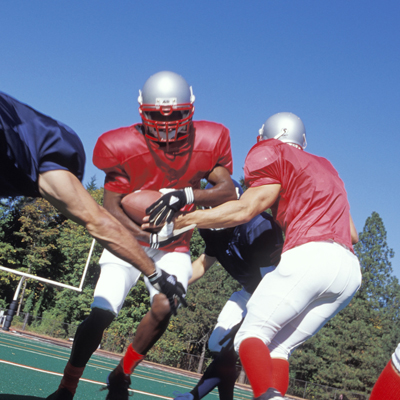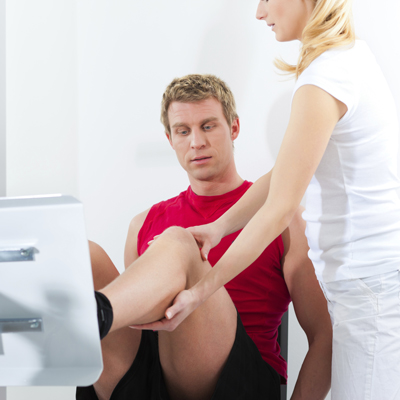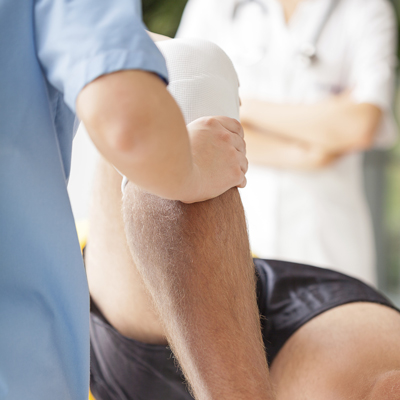Overview
ACL injuries – injuries to the anterior cruciate ligament in the knee – affect more than 250,000 Americans each year. They are most prevalent in athletes and people ages 15 to 45.
The good news is that ACL injuries can be successfully treated before long-term damage occurs. At Cleveland Clinic, we have a team of sports medicine specialists, orthopaedic surgeons, athletic trainers, and physical therapists who can offer leading-edge diagnosis, treatment and rehabilitation options.
Cleveland Clinic’s Orthopaedic & Rheumatologic Institute offers expert diagnosis, treatment and rehabilitation for adults and children with bone, joint and connective tissue disorders.
ACL Overview
The knee joint is the largest joint in the human body. It is a complex hinge joint where bone, cartilage (for cushioning) and ligaments come together. It is at the knee that the femur bone (the thigh) and the tibia bone (the shin) meet and are held together by various ligaments, which allow you to walk, run and bend.
The ACL – anterior cruciate ligament –in athletes is one of the most important ligaments in the knee. The ACL is in the center of the knee and connects the thigh bone to the shin bone, preventing abnormal rotation of the knee joint. The purpose of your ACL is to keep your knee from giving out or shifting too far out of position.
Causes

What are the causes of ACL injuries?
An anterior cruciate ligament (ACL) injury occurs when the ligament is over-stretched or torn. A tear can be partial or full. When a tear happens, it creates instability in the knee, which often causes pain and difficulty walking, running, pivoting, jumping and landing.
Injuries to the ACL can result from sports, falls or other traumas. The knee joint is often put at risk during athletic activities, and ACL tears are one of the most common injuries for athletes. Injuries to the knee can be some of the most devastating and difficult injuries from which to recover. If not treated it can lead to both short and long-term problems.
Most ACL tears are non-contact injuries. You can tear your ACL when you twist your knee too forcefully, or when you plant your foot and then suddenly change direction. A majority of all ACL injuries arise from these cutting and planting maneuvers used in all sports. This happens often in sports when the athlete needs to quickly change direction while in motion or when he or she hyperextends the knee while running.
High-risk sports for ACL tears are football, basketball, soccer and volleyball. And females are four times more likely to have an ACL tear than male in the same sport at the same level. ACL injuries are becoming increasingly more common as more and more people participate in athletic activities. In college football, the risk of tearing the ACL for any particular athlete can be as high as 16 percent over a four-year timeframe.
Symptoms
Symptoms and Signs of an ACL Injury
- Typically, the person will feel or hear a “pop” or a sense that the knee has “given out” on them.
- The athlete is usually unable to continue to play due to pain and instability.
- After the injury, the knee may become swollen within a few minutes or it may take a few hours.
- The knee may stay swollen for two to four weeks.
- When the swelling subsides, the instability is still present and will give the feeling of unsteadiness
Treatments

Immediate Treatment if an ACL Injury is Suspected
- Apply ice for 20 minutes
- Lightly compress the injured site with an elastic bandage
- Use crutches if there is any pain or instability when standing
- Raise the leg above the level of the heart
- Use pain relievers such as nonsteroidal anti-inflammatory drugs (i.e., ibuprofen) as needed
- See your doctor as soon as possible if you think you have an ACL injury
- Do not play sports or do other activities until you have seen a doctor to find out the extent of the problem and undergo treatment
How is an ACL tear treated?
The immediate goal after an ACL tear is the same regardless of treatment options. Patients with isolated ACL tears are required to achieve normal walking, nearly full motion and strength, and reduced swelling.
Each case is unique and will require consultation with an orthopaedic specialist who can examine the MRI to get a full picture of the ACL injury. This can help you in your decision on how to address an ACL injury.
Surgical treatments
ACL reconstruction surgery can be done to rebuild the ligament in the center of your knee with a new ligament. The tissue to replaceyour damaged ACL can come from an autograft (your own body) or an allograft (donor tissue).
The procedure is usually done by knee arthroscopy, which involves using smaller, less invasive surgical cuts to insert surgicalinstruments and a small camera inside the knee. The camera is connected to a video monitor so the surgeon can see all of the ligaments and tissues inside your knee. Your surgeon will fix any other damage found and will then remove and replace your ACL with tissue (either autograft or allograft) that will become your new ligament. Your surgeon will attach the new ligament to the bone with screws (or other devices). Once firmly in place, the surgeon will close your cuts with sutures (stitches) and put a dressing on them.
Non-operative Approach
Some individuals who tear their ACL in an occasional recreational activity may choose to have only rehabilitation to their knee. People who elect to not to have surgery to repair the ACL are often less active or are non-athletes who will not need to do any cutting or pivoting required in sports. Most people with this type of lifestyle will be able to function normally without having surgery to reconstruct their ACL.
Active individuals often question whether they should have surgery or wear a knee brace. Research has shown that custom and off-the-shelf braces do not protect against further knee injury in the athletic, active population. If you and your physician choose a brace, please discuss the risks of additional knee injuries and the type of brace to be worn.
Note: Unrepaired ACL tears can lead to further knee damage. ACL reconstruction surgery is recommended in many cases. Some people can live with a torn ACL or a partially torn ACL, but many people will continue to have instability with daily, occupational or athletic activities.
Diagnosis

How is an ACL injury diagnosed?
Most ACL injuries can be diagnoses by a physical exam. An X-ray will be taken to rule out any injuries to a bone. An MRI (magnetic resonance imaging) scan may be done to get a clear picture of the knee. An MRI allows the orthopaedic specialist to see all of the soft tissue of the knee—the ligaments, the cartilage and the muscle. Any tear in the ACL will show up clearly on an MRI.
If the athlete wants to continue in his/her sport, ACL reconstruction is typically necessary. Thirty to 40 years ago, tearing the ACL meant an athlete’s career was over, but today it is just put on hold until ACL reconstruction surgery and rehabilitation have been completed.
After Surgery
What happens after ACL reconstruction?
The first week after surgery, the patient will perform gentle range-of-motion exercises, strengthening exercises, and some weight-bearing exercises. As the time progresses, formal physical therapy is started, including functional movement, advanced strengthening and balance activities. This is at the discretion of your treating surgeon, as timeframes may vary depending on the severity of your injury and complexity of your surgery.
After about three to four months, a walking or jogging program is often started depending upon the patient’s level of physical activity prior to the injury. For athletes, sport-specific activities such as hopping, jumping and agility drills will become part of rehabilitation at the four to five month timeframe.
Following ACL reconstruction and rehabilitation, the patient should be able to return to normal activity at around the six month mark. The athlete should be able to return to normal activity anywhere from six to nine months.
Prevention
How can ACL injuries be prevented?
Training techniques have attempted to minimize the risk of ACL tears. These techniques include fine motor control of the lower extremities as well as increasing strength, endurance and flexibility. Studies show that training programs supervised by sports health professionals will improve athletes’ leg and trunk strength and jump-landing techniques. Proper training has been shown to decrease ACL injury rates in basketball, volleyball and soccer.
Training programs designed to teach, strengthen and condition women to land properly may significantly decrease the risk of ACL injury. Illustrations show proper landing technique vs. improper landing.
Luckily, with advances in surgical techniques (like ACL reconstruction) and rehabilitation, an ACL knee injury is a season-ending injury – NOT a career-ending one.
Why are women more prone to ACL Injuries than men?
While anyone can suffer an ACL injury, female athletes are up to eight times more likely to sustain ACL injuries than men. We do not fully understand why, however, research shows that females tend to change direction (“cut,” “jump” and “jump stop”) differently than males. It is these types of maneuvers that are often to blame for non-contact ACL tears. Thankfully, data also shows that supervised training programs to improve leg strength and jumplanding techniques may have an impact.
Studies of female athletes at the high school and collegiate levels have demonstrated that supervised training programs designed to improve leg strength and jump-landing technique may decrease ACL injury rates in volleyball and basketball players. Emerging data suggest similar improvements in soccer players as well. Programs to improve lower body and trunkstrength that subsequently re-train jumping and cutting mechanics seem to decrease the risk of ACL tear in girls and young women who participate in the strength and prevention program compared to those who don’t.
Jump Right Program
Cleveland Clinic Sports Medicine offers a jump training program – Jump-Right – that is designed to help female athletes increase leg strength and decrease risk of serious knee injuries.
This six- to eight-week program is aimed at teaching athletes proper jumping and landing mechanics, beginning with fundamental warm-up and jumping techniques, and gradually progressing to advanced-level plyometrics.
In addition to injury-risk reduction, our Jump-Right program may enhance athletic performance. Plyometric programs have been shown to increase vertical jumps, improve acceleration and improve the ability to change direction. All of these factors are instrumental to an athlete’s success for a safe return to sports.
For more information on the Jump-Right Training strength and injury prevention program, call 216.518.3475.
Patient Services
MyChart
MyChart is a secure online tool that provides personalized health information from the privacy of your home at any time, day or night. Learn more or login now.
Appointments
To make an appointment with an orthopaedic specialist, call:
- Cleveland Appointments: 216.444.2606
- Akron Appointments: 330.344.2663
- Canton Appointments: 330.489.1362
- Dover Appointments: 330.343.3335
Virtual Visits
You can now stay connected to your healthcare team through virtual visits, using your smartphone, tablet or computer.
Why go virtual? It's an easy, convenient and secure way to see your provider face-to-face without having to leave home. This saves you travel time, parking fees and time spent in the waiting room — and you can also have a loved one or caregiver join you. If appropriate, you can also get a prescription sent to the pharmacy of your choice.
Many insurance companies cover the cost of virtual visits, so check with your insurance company ahead of time. Interested in getting started? Call your provider to find out what virtual visit options are available.
Virtual Visits with Orthopaedics
New patients with common knee injuries or knee pain.
Established patients scheduling follow-up care appointments such as:
- Post-Surgical & wound check visits.
- Fracture care follow-up.
- Injection follow-up.
- Musculoskeletal injury follow-up.
- Per-operative teaching prior to surgery.
Virtual Second Opinion
If you cannot travel to Cleveland Clinic, help is available. You can connect with Cleveland Clinic specialists from any location in the world via a phone, tablet, or computer, eliminating the burden of travel time and other obstacles. If you’re facing a significant medical condition or treatment such as surgery, this program provides virtual access to a Cleveland Clinic physician who will review the diagnosis and treatment plan. Following a comprehensive evaluation of medical records and labs, you’ll receive an educational second opinion from an expert in their medical condition covering diagnosis, treatment options or alternatives as well as recommendations regarding future therapeutic considerations. You’ll also have the unique opportunity to speak with the physician expert directly to address questions or concerns.
Why Choose Us?
Why should I choose Cleveland Clinic?
Our team of orthopaedic physicians and surgeons in Cleveland Clinic’s Orthopaedic & Rheumatologic Institute offer the most comprehensive and personalized solutions for all manner of ACL tear or knee injury. We can help you get back to your everyday activities.
Resources
Stay Connected
- Explore our services, locations and more
- Subscribe to Health Essentials e-News for expert insights on nutrition, health and wellness. Get free guides to common conditions, too
- Sign up for our Competitive Edge e-newsletter for athletes, coaches, parents and active individuals for latest sports health topics, concerns and trends.
- Find a wealth of family health & wellness tips
- YouTube